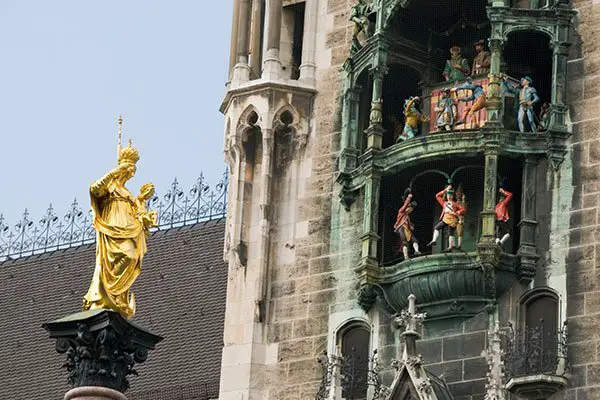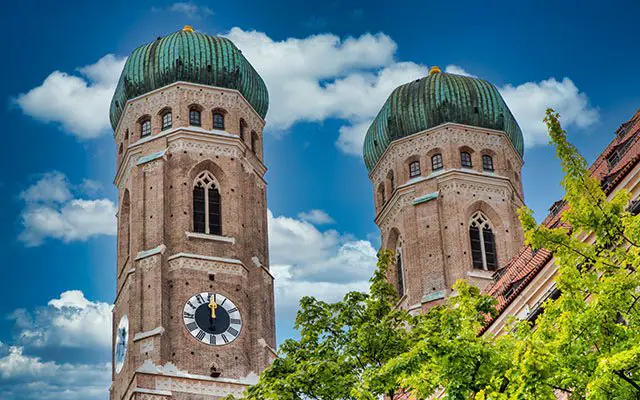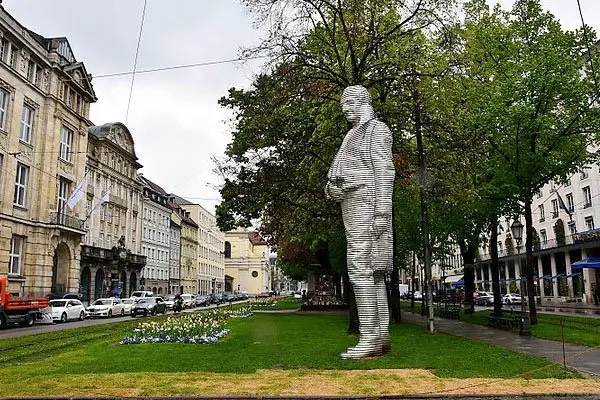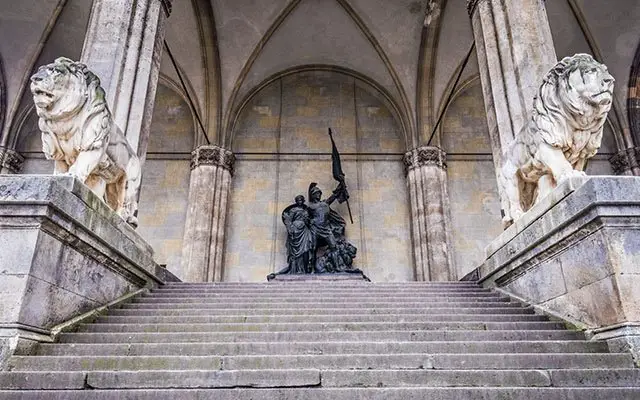Before doing anything on your visit to Munich, we absolutely recommend that you first take a walk throughout the Munich Old Town (Altstadt).
You’ll gain a fantastic orientation of the city, discover amazing places to eat, drink and relax, and best of all, you’ll grasp a good sense of the city’s decadent and historical past.
Munich barely managed to escape total destruction in World War II, and many buildings from the Renaissance era remained standing and undamaged in the aftermath of the Allies bombing efforts over the city.
As such Munich – and in particular the Munich Old Town – is noted as being one of the most beautiful cities in Bavaria.
Being free travellers ourselves, most of us likely won’t want to experience a fully structured walking tour (Unless it’s a particularly difficult to navigate destination), so in this post on the Munich Old Town, we’ve chosen a few highlighted spots, leaving the rest up to you to discover.
What is the Meaning of Altstadt?
Altstadt translated simply means Old Town or Historic City Center.
Certainly, as you weave your way through and around the small cobbled streets of this ancient part of the city, you’ll both wonder and admire the beautiful architecture of the Munich Altstadt.
Trust us when we say that you’ll definitely start to really FEEL the history of this magnificent city.
Sendlinger Tör & around

A great place to begin your discovery of the city and Munich Old Town is at Sendlinger Tor.
This is one of the three city gates (Tör) that remain from medieval times.
What was once the main trade road to Italy, is now a pedestrian shopping street with small boutiques and high-street fashion outlets.
This is a pleasant area to stroll around and you can also try one of our favourite Cafes, Patolli here.
Photo credit : creativecommons.org

Not far from Sendlinger Tor you’ll find the Asamkirche.
This small decadently outfitted chapel is considered one of the most important buildings from the late Baroque era in southern Germany.
Don’t be deceived by the small size though as you’ll be super impressed when you see the interior.
Behind the extravagant detailed interior, you’ll start to appreciate the powerful concept behind the vision that inspired the Asam Brothers creation here.
Clever use of the gradation of light from the lower ground to the brightly lit ceiling is the basis for the supposed depiction of a sense of transcendence, of one “arising from dark to glory”.
A big plus here is that the Asamkirche is another of the Munich Old Town sights that are totally free to visit!
Marienplatz : The Hub of Munich Old Town

Feeling a little overwhelmed? The next stop will cheer you up!
In the heart of the city, Marienplatz (Mary’s Square), you’ll feel an energetic vibe with the fusion of the past and the present coming together.
Although no longer serving its original purpose as a grain market and as a field for tournaments, Marienplatz is now one of the most popular shopping areas of the Munich Old Town
The square is an important place for various city celebrations such as Weihnachtsmarkt (Christmas market).
Here you can also celebrate and enjoy the party vibe with FC Bayen fans after any of their Champions League matches (and they’ve played in plenty of them).
The most remarkable sight here is the new town hall.
Famous for the Glockenspiel, you can watch the 32 puppets reenacting the wedding fest of Herzog Wilhelm V. and Renate from Lothringen and the dance celebration (Schläfflertanz) after the horrific plague in the 1500s.
Top Alstadt Tip: To catch a better view of the Glockenspiel, book yourself a window seat at Café Glockenspiel just opposite. Catch the best view while enjoying a Bavarian meal without the crowd!
The Glockenspiel is played every day at 11:00, 12:00 and 21:00.
(From March till October, an additional showing at 17:00)

Around Marienplatz, you can easily spend half a day exploring and looking at different historical statues and decore.
You may have visited the New Town Hall, but you should also check out the wonderfully white Munich Old Town Hall as well and perhaps if you’re interested, the Munich Toy Museum within!
A significant statue you’ll find here is the Märiensäulen (Mary’s column). This golden sculpture was built to honour Mary for keeping Munich safe from the Swedish during the Thirty Years’ War. It was, however, not until 1854, that the square was renamed as Marienplatz, to give hope to the end of the cholera epidemic.
To get a refreshing break from the hustle and bustle, you can head to the Viktualienmarkt for some gourmet goodies. There you’ll find a great variety of small stalls selling local delicacies such as cheeses, olives and deli goods.
An ideal spot to fill your picnic basket! Another awesome cafe here (and another of our favourites), found next to the soup kitchen, is Kaffeerösterei Viktualienmarkt.
Frauenkirche: Munich's Amazing Cathedral

Not far from Marienplatz, the Frauenkirche (Cathedral of Our Dear Lady) is another iconic building that you would have recognized from many Munich postcards and other souvenirs of the city.
Distinguished by two “onion towers”, it’s one of the most important churches in Munich. Not only you can visit the cathedral itself, but you can also go up to the south tower (by lift or walking) that is close to 100m high.
It offers one of the best city viewpoints of Munich. Of course, the visit is not complete without checking out the legendary devil’s footprint at the entrance.
Wondering what the legend of the Devils Footprint is all about? Then please check out our recent post on the Frauenkirche to fulfil your curiosity and gain more insights about the cathedral!

Photo credit : creativecommons.org
Since we are on the topic of worship, there is a bazaar pilgrimage just a block away from the Frauenkirche called Promenadeplatz (Walking Square).
Here, amongst important historical statues like the pictured statue of the elector and king of Bavaria Max Emanuel (Maximilian II), you’ll also find the “Michael Jackson Memorial”.
Not an actual official memorial site established by the government, but an initiation set up by his fans after his sudden death in 2009.
Up to this day, you’ll still find posters, fresh flowers and candles attributed to the 90’s King of Pop.
Surprisingly, although this shrine to MJ is at the foot of the statue of Orlando di Lasso, a renowned composer and conductor in the Renaissance, no one seems to mind.

Odeonsplatz: Witness the Passage of Time
Wandering further north from Promenadeplatz in the Munich Old Town you’ll find yourself passing small boutiques and cafes before arriving at Odeonsplatz.
This landmark brings a great sense of the historical background of Munich from the renaissance period to modern history.
The Feldherrnhalle (Field Marshall’s Hall) is guarded by two marble lions. They stand proudly between the war heroes, Count of Tilly and General von Wrede from the Thirty Years’ War in the 1600s and the battle against Napoleon respectively.
The centre statue at the back was later added to celebrate the victory from the Franco-German War of 1870/71, which led to the unification of Germany.

Beyond the glory, this square also has a dark history. In 1933, after the Nazi’s gained power, the hall became a memorial from the failed Beer Hall Putsch that took place ten years earlier.
A monument was installed with martyrs’ name on it and was fully guarded by the SS. Anyone who wanted to pass must give the Nazi Salute (Deutsche Gruß). Many eventually found a back way to bypass it.
This so-call Drückebergergasserl, roughly translated as “dodgers’ alley”, is now marked in gold as a reminder of this resistance. The monument was also smashed into pieces shortly after the war ended.
These days, Odeonsplatz has a much more relaxing vibe. It’s a local meeting point, and throughout the year, various events are held here.
Look out for the Open-air classical music concert in July and the Streetlife Festival in September.

Whilst in Odeonsplatz, you can also visit the majestic Munich Residenz just right next to the plaza. This Versailles-like palace started life as a humble castle in 1385, but throughout the long reign of the powerful Wittelsbach dynasty, was transformed into an opulent residence and government administration center.
Here, you can see the extravagant lifestyle of the Kings and Dukes of Bavaria over the past centuries. The museum showcases different rooms with varied décor from Baroque, Rococo to Neoclassicism. Precious jewels and reliquaries are also on display.
By the end of the museum visit, you’ll probably feel you need a bit of time to absorb everything. So what a better way to relax in the court garden, and just let time pass by.

Is There An Old Town In Munich?
You bet there is, and we’ve only touched on some of the amazing sights that you can visit here in the Oldest part of Munich.
There are still many more points of interest in the Altstadt to be discovered – but there’s no need to squeeze it all in one walk, right?
The places we suggested are just starters to inspire you to walk around the city and explore the wonderful Munich Old Town.
It can also be nice to rent a bike to snake around the city. If you don’t have your own bike, you can easily rent a city bike. Here, you can see how the city bike rental system works.
As the Altstadt captures so many layers of history, no matter if you are a visitor or a local here, there are always unexpected surprises around the corner just waiting to be discovered.
What's Your favourite spot in the Altstadt?
This post was updated in June of 2022.
We’d love to hear from you guys with any comments you have, or perhaps topics or points of interest in the Munich Old Town that you’d like us to write about.
Please send us a message via our CONTACTS PAGE.
Cheers and thanks for reading.

